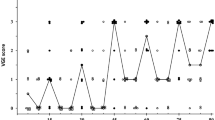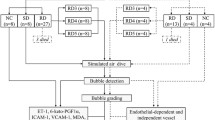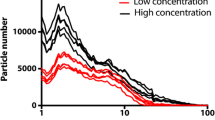Abstract
Introduction
Perfluorocarbon emulsions (PFC) and nitric oxide (NO) releasing agents have on experimental basis demonstrated therapeutic properties in treating and preventing the formation of venous gas embolism as well as increased survival rate during decompression sickness from diving. The effect is ascribed to an increased solubility and transport capacity of respiratory gases in the PFC emulsion and possibly enhanced nitrogen washout through NO-increased blood flow rate and/or the removal of endothelial micro bubble nuclei precursors. Previous reports have shown that metabolic gases (i.e., oxygen in particular) and water vapor contribute to bubble growth and stabilization during altitude exposures. Accordingly, we hypothesize that the administration of PFC and NO donors upon hypobaric pressure exposures either (1) enhance the bubble disappearance rate through faster desaturation of nitrogen, or in contrast (2) promote bubble growth and stabilization through an increased oxygen supply.
Methods
In anesthetized rats, micro air bubbles (containing 79 % nitrogen) of 4–500 nl were injected into exposed abdominal adipose tissue. Rats were decompressed in 36 min to 25 kPa (~10,376 m above sea level) and bubbles studied for 210 min during continued oxygen breathing (FIO2 = 1). Rats were administered PFC, NO, or combined PFC and NO.
Results
In all groups, most bubbles grew transiently, followed by a stabilization phase. There were no differences in the overall bubble growth or decay between groups or when compared with previous data during oxygen breathing alone at 25 kPa.
Conclusion
During extreme altitude exposures, the contribution of metabolic gases to bubble growth compromises the therapeutic effects of PFC and NO, but PFC and NO do not induce additional bubble growth.




Similar content being viewed by others
References
Abrams J (1985) Hemodynamic effects of nitroglycerin and long-acting nitrates. Am Heart J 110(1 Pt 2):216–224
Altman DG (1991) Practical statistics for medical research. Chapman and Hall, London
Armitage P, Berry G (1987) JNS. M Statistical methods in medical research. Blackwell Scientific, Oxford
Bondi M, Cavaggioni A, Michieli P, Schiavon M, Travain G (2005) Delayed effect of nitric oxide synthase inhibition on the survival of rats after acute decompression. Undersea Hyperb Med 32(2):121–128
Burkard ME, Van Liew HD (1994) Simulation of exchanges of multiple gases in bubbles in the body. Respir Physiol 95(2):131–145
Castro CI, Briceno JC (2010) Perfluorocarbon-based oxygen carriers: review of products and trials. Artif Organs 34(8):622–634. doi:10.1111/j.1525-1594.2009.00944.x
Dainer H, Nelson J, Brass K, Montcalm-Smith E, Mahon R (2007) Short oxygen prebreathing and intravenous perfluorocarbon emulsion reduces morbidity and mortality in a swine saturation model of decompression sickness. J Appl Physiol 102(3):1099–1104. doi:10.1152/japplphysiol.01539.2005
Dart TS, Butler W (1998) Towards new paradigms for the treatment of hypobaric decompression sickness. Aviat Space Environ Med 69(4):403–409
Dromsky DM, Spiess BD, Fahlman A (2004) Treatment of decompression sickness in swine with intravenous perfluorocarbon emulsion. Aviat Space Environ Med 75(4):301–305
Dujic Z, Palada I, Valic Z, Duplancic D, Obad A, Wisloff U, Brubakk AO (2006) Exogenous nitric oxide and bubble formation in divers. Med Sci Sports Exerc 38(8):1432–1435. doi:10.1249/01.mss.0000228936.78916.23
Eckmann DM, Armstead SC (2006) Influence of endothelial glycocalyx degradation and surfactants on air embolism adhesion. Anesthesiology 105(6):1220–1227
Flaim SF (1994) Pharmacokinetics and side effects of perfluorocarbon-based blood substitutes. Artif Cells Blood Substit Immobil Biotechnol 22(4):1043–1054. doi:10.3109/10731199409138801
Foster PP, Conkin J, Powell MR, Waligora JM, Chhikara RS (1998) Role of metabolic gases in bubble formation during hypobaric exposures. J Appl Physiol 84(3):1088–1095
Hyldegaard O, Madsen J (1989) Influence of heliox, oxygen, and N2O–O2 breathing on N2 bubbles in adipose tissue. Undersea Biomed Res 16(3):185–193
Hyldegaard O, Madsen J (2007) Effect of hypobaric air, oxygen, heliox (50:50), or heliox (80:20) breathing on air bubbles in adipose tissue. J Appl Physiol 103(3):757–762. doi:10.1152/japplphysiol.00155.2007
Hyldegaard O, Moller M, Madsen J (1991) Effect of He–O2, O2, and N2O–O2 breathing on injected bubbles in spinal white matter. Undersea Biomed Res 18(5–6):361–371
Hyldegaard O, Kerem D, Melamed Y (2001) Effect of combined recompression and air, oxygen, or heliox breathing on air bubbles in rat tissues. J Appl Physiol 90(5):1639–1647
Lango T, Morland T, Brubakk AO (1996) Diffusion coefficients and solubility coefficients for gases in biological fluids and tissues: a review. Undersea Hyperb Med 23(4):247–272
Lowe KC (1987) Perfluorocarbons as oxygen-transport fluids. Comp Biochem Physiol A Comp Physiol 87(4):825–838
Lutz JHG (1984) Perflurochemicals as a treatment of decompression sickness in rats. Plugers Arch 401:174–177
Lynch PRKL, Vinciquerra T, Shaffer TH (1989) Effects of intravenous perflurocarbon and oxygen breathing on acute decompression sickness in the hamster. Undersea Biomed Res 16:275–281
Madsen J, Malchow-Moller A, Waldorff S (1975) Continuous estimation of adipose tissue blood flow in rats by 133Xe elimination. J Appl Physiol 39(5):851–856
Mahon RT, Dainer HM, Nelson JW (2006) Decompression sickness in a swine model: isobaric denitrogenation and perfluorocarbon at depth. Aviat Space Environ Med 77(1):8–12
Markos F, Ruane O’Hora T, Noble MI (2013) What is the mechanism of flow mediated arterial dilatation. Clin Exp Pharmacol Physiol. doi:10.1111/1440-1681.12120
Mollerlokken A, Berge VJ, Jorgensen A, Wisloff U, Brubakk AO (2006) Effect of a short-acting NO donor on bubble formation from a saturation dive in pigs. J Appl Physiol 101(6):1541–1545. doi:10.1152/japplphysiol.01191.2005
Muehlberger PM, Pilmanis AA, Webb JT, Olson JE (2004) Altitude decompression sickness symptom resolution during descent to ground level. Aviat Space Environ Med 75(6):496–499
Noveck RJ, Shannon EJ, Leese PT, Shorr JS, Flaim KE, Keipert PE, Woods CM (2000) Randomized safety studies of intravenous perflubron emulsion. II. Effects on immune function in healthy volunteers. Anesth Analg 91(4):812–822
Rasband W (1996) Image processing and analysis (version 1.61). National Institutes of Health Research Services Branch, NIMH Washington DCS. http://rsb.info.nih.gov/nih-image/download.html
Randsoe T, Hyldegaard O (2009) Effect of oxygen breathing and perfluorocarbon emulsion treatment on air bubbles in adipose tissue during decompression sickness. J Appl Physiol 107(6):1857–1863. doi:10.1152/japplphysiol.00785.2009
Randsoe T, Hyldegaard O (2012) Effect of oxygen breathing on micro oxygen bubbles in nitrogen-depleted rat adipose tissue at sea level and 25 kPa altitude exposures. J Appl Physiol 113(3):426–433. doi:10.1152/japplphysiol.00193.2012
Randsoe T, Hyldegaard O (2013) Threshold altitude for bubble decay and stabilization in rat adipose tissue at hypobaric exposures. Aviat Space Environ Med 84(7):675–683
Randsoe T, Kvist TM, Hyldegaard O (2008) Effect of oxygen and heliox breathing on air bubbles in adipose tissue during 25-kPa altitude exposures. J Appl Physiol 105(5):1492–1497. doi:10.1152/japplphysiol.90840.2008
Riess JG (2005) Understanding the fundamentals of perfluorocarbons and perfluorocarbon emulsions relevant to in vivo oxygen delivery. Artif Cells Blood Substit Immobil Biotechnol 33(1):47–63
Spiess BD (1995) Perfluorocarbon emulsions: one approach to intravenous artificial respiratory gas transport. Int Anesthesiol Clin 33(1):103–113
Spiess BD (2009) Perfluorocarbon emulsions as a promising technology: a review of tissue and vascular gas dynamics. J Appl Physiol 106(4):1444–1452. doi:10.1152/japplphysiol.90995.2008
Spiess B, McCarthy RJ, Tuman KJ, Woronowicz AW, Tool KA, Ivankovi AD (1988) Treatment of decompression sickness with a perflurocarbon emulsion (FC-43). Undersea Biomed Res 15:31–37
SPSS (1998) [Computer program] Statistical package of the social sciences. Chicago
Torres Filho IP, Torres LN, Spiess BD (2012) In vivo microvascular mosaics show air embolism reduction after perfluorocarbon emulsion treatment. Microvasc Res 84(3):390–394. doi:10.1016/j.mvr.2012.08.002
Tzeng TB, Fung HL (1992) Pharmacokinetic/pharmacodynamic relationship of the duration of vasodilating action of organic mononitrates in rats. J Pharmacol Exp Ther 261(2):692–700
Van Liew HD, Burkard ME (1995) Simulation of gas bubbles in hypobaric decompressions: roles of O2, CO2, and H2O. Aviat Space Environ Med 66(1):50–55
Van Liew HD, Conkin J, Burkard ME (1993) The oxygen window and decompression bubbles: estimates and significance. Aviat Space Environ Med 64(9 Pt 1):859–865
Weathersby PK, Homer LD (1980) Solubility of inert gases in biological fluids and tissues: a review. Undersea Biomed Res 7(4):277–296
Wisloff U, Richardson RS, Brubakk AO (2003) NOS inhibition increases bubble formation and reduces survival in sedentary but not exercised rats. J Physiol 546(Pt 2):577–582
Wisloff U, Richardson RS, Brubakk AO (2004) Exercise and nitric oxide prevent bubble formation: a novel approach to the prevention of decompression sickness? J Physiol 555(Pt 3):825–829. doi:10.1113/jphysiol.2003.055467
Zhu J, Hullett JB, Somera L, Barbee RW, Ward KR, Berger BE, Spiess BD (2007) Intravenous perfluorocarbon emulsion increases nitrogen washout after venous gas emboli in rabbits. Undersea Hyperb Med 34(1):7–20
Acknowledgments
The support given from Alliance Pharmaceutical Corp., San Diego, CA, for supplying the perflurocarbon emulsion—Oxygent®—is greatly appreciated. This project would have been impossible without it. The assistance of laboratory technician Mr. Ian Godfrey for his help in the manufacture of the glass micropipettes is greatly appreciated. Thanks are given to senior Hyperbaric Supervisor Michael Bering Sifakis in assisting us with chamber support and maintenance. The Lundbeck Foundation and the Laerdal Foundation for Acute Medicine supported the present work.
Author information
Authors and Affiliations
Corresponding author
Additional information
Communicated by Dag Linnarsson.
Rights and permissions
About this article
Cite this article
Randsøe, T., Hyldegaard, O. Treatment of micro air bubbles in rat adipose tissue at 25 kPa altitude exposures with perfluorocarbon emulsions and nitric oxide. Eur J Appl Physiol 114, 135–146 (2014). https://doi.org/10.1007/s00421-013-2749-x
Received:
Accepted:
Published:
Issue Date:
DOI: https://doi.org/10.1007/s00421-013-2749-x




